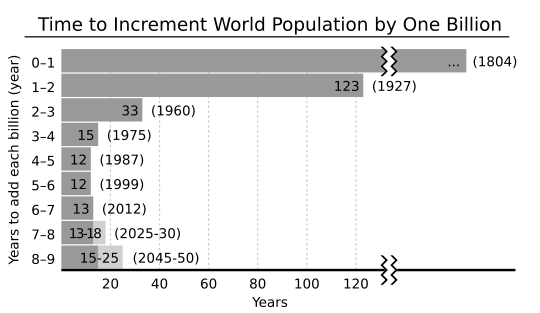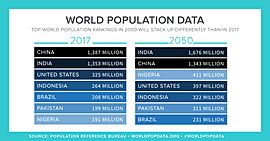Population facts for kids
Population is the term typically used to refer to the number of people in a single area. Governments conduct a census to quantify the size of a resident population within a given jurisdiction. The term is also applied to non-human animals, microorganisms, and plants, and has specific uses within such fields as ecology and genetics.
Etymology
The word population is derived from the Late Latin populationem (a people, a multitude), which itself is derived from the Latin word populus (a people).
World human population
According to the UN the world's population surpassed 8 billion on 15 November 2022, a gain of 1 billion since 12 March 2012. According to a separate estimate by the United Nations, Earth's population exceeded seven billion in October 2011. According to UNFPA, growth to such an extent offers unprecedented challenges and opportunities to all of humanity.
According to papers published by the United States Census Bureau, the world population hit 6.5 billion on 24 February 2006. The United Nations Population Fund designated 12 October 1999 as the approximate day on which world population reached 6 billion. This was about 12 years after the world population reached 5 billion in 1987, and six years after the world population reached 5.5 billion in 1993. The population of countries such as Nigeria is not even known to the nearest million, so there is a considerable margin of error in such estimates.
Researcher Carl Haub calculated that a total of over 100 billion people have probably been born in the last 2000 years.
Predicted growth and decline
Population growth increased significantly as the Industrial Revolution gathered pace from 1700 onwards. The last 50 years have seen a yet more rapid increase in the rate of population growth due to medical advances and substantial increases in agricultural productivity, particularly beginning in the 1960s, made by the Green Revolution. In 2017 the United Nations Population Division projected that the world's population will reach about 9.8 billion in 2050 and 11.2 billion in 2100.
In the future, the world's population is expected to peak, after which it will decline due to economic reasons, health concerns, land exhaustion and environmental hazards. According to one report, it is very likely that the world's population will stop growing before the end of the 21st century. Further, there is some likelihood that population will actually decline before 2100. Population has already declined in the last decade or two in Eastern Europe, the Baltics and in the Commonwealth of Independent States.
The population pattern of less-developed regions of the world in recent years has been marked by gradually declining birth rates. These followed an earlier sharp reduction in death rates. This transition from high birth and death rates to low birth and death rates is often referred to as the demographic transition.
Population planning
Human population planning is the practice of altering the rate of growth of a human population. Historically, human population control has been implemented with the goal of limiting the rate of population growth. In the period from the 1950s to the 1980s, concerns about global population growth and its effects on poverty, environmental degradation, and political stability led to efforts to reduce population growth rates. While population control can involve measures that improve people's lives by giving them greater control of their reproduction, a few programs, most notably the Chinese government's one-child per family policy, have resorted to coercive measures.
In the 1970s, tension grew between population control advocates and women's health activists who advanced women's reproductive rights as part of a human rights-based approach. Growing opposition to the narrow population control focus led to a significant change in population control policies in the early 1980s.
See also
 In Spanish: Población para niños
In Spanish: Población para niños
- Community (ecology)
- Human overpopulation
- List of countries by population
- Lists of organisms by population
- Population ethics
- Population geography



